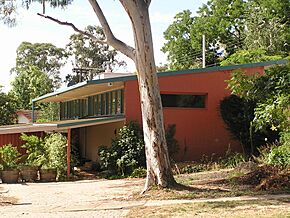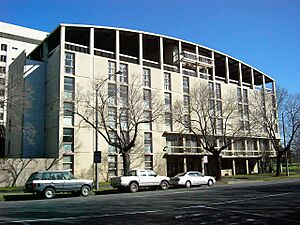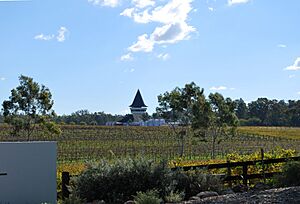Robin Boyd (architect) facts for kids
Quick facts for kids
Robin Boyd
|
|
|---|---|

|
|
| Born |
Robin Gerard Penleigh Boyd
3 January 1919 |
| Died | 16 October 1971 (aged 52) Melbourne, Victoria
|
| Nationality | Australian |
| Occupation | Architect |
| Spouse(s) | Patricia Madder (m. 1941; died 2009) |
| Parent(s) | Penleigh Boyd, Edith Anderson |
| Awards | RAIA Gold Medal (1969) |
| Buildings |
|
| Design | International Modern Movement |
Robin Boyd (born January 3, 1919 – died October 16, 1971) was an Australian architect, writer, and teacher. He was a big supporter of the International Modern Movement in Australian architecture. This style focuses on simple, clean designs.
Boyd wrote an important book called The Australian Ugliness (1960). In this book, he talked about how Australian buildings, especially in the suburbs, often lacked a clear design style. He believed many buildings were not well-planned.
Even though he didn't get to design many huge buildings, Robin Boyd was famous for his clever and new designs for smaller homes.
Contents
Early Life and Family Background
Robin Boyd came from a very artistic family in Australia. Many of his relatives were painters, sculptors, architects, and writers. His father, Penleigh Boyd, was a painter. Robin's own son, also named Penleigh, became an architect too.
His aunt was Joan Lindsay, who wrote the famous book Picnic at Hanging Rock. Robin's mother, Edith, was also a talented painter. Her family was well-known, with her father being a director of public education.
Robin and his older brother, Pat, spent their early years in a family home called 'The Robins' near Melbourne. Sadly, Robin's father passed away in a car accident when Robin was very young. His mother, Edith, was able to support her sons thanks to her inheritance.
Robin went to school in Melbourne. He loved reading, movies, and jazz music. He decided early on that he wanted to be an architect. After finishing school, he trained with a leading architect named Kingsley Henderson. He served in Papua New Guinea during World War II and then continued his architecture career in 1945.
Robin Boyd's Architecture Career
Robin Boyd first became known in the late 1940s. He promoted homes that were affordable, practical, and used modern designs. Many of his projects were houses, but he also designed bigger buildings. These included the Domain Park apartment tower and the John Batman Motor Inn in Melbourne. He also designed the headquarters for the Winston Churchill Memorial Trust in Canberra.
From 1947 to 1953, Boyd was the first Director of the Royal Victorian Institute of Architects Small Homes Service. He also wrote weekly articles for The Age newspaper about this service. The Small Homes Service offered designs for affordable houses. These designs tried to include modern styles and smart layouts. They were sold to the public for a small fee. This work made Robin Boyd a well-known name in Victoria.
In 1948, Boyd received a scholarship that allowed him to travel through Europe. This trip greatly influenced his later work and ideas.
In 1953, he started a partnership with two other important architects, Frederick Romberg and Roy Grounds. Their firm became very important in Australian architecture. Through the 1950s and 1960s, Boyd designed many significant houses in a regional style. One example is a house he designed in Canberra for the historian Manning Clark.

Robin Boyd was a very busy architect. He designed over 200 projects in his career. Most of these were his own designs. He also worked with partners on some early projects. After 1962, he continued to work with Frederick Romberg until his death.
Boyd was also a very important writer, speaker, and teacher. He strongly supported modern design. In his book The Australian Ugliness (1960), he criticized what he called "featurism." This was his term for adding too many decorations that made a building look messy. He believed that the overall design was more important than small, fancy details.
He described "featurism" as:
... not simply a decorative technique, it starts in concepts and extends upwards through the parts of the numerous trimmings. It may be defined as the subordination of the essential whole and the accentuation of selected separate features.
For many years, he directed The Age Small Homes Service. He influenced many people with his popular weekly articles. He also taught architecture at the University of Melbourne. In 1956-57, he taught at the Massachusetts Institute of Technology in Boston. This opportunity was offered by Walter Gropius, a friend of Boyd's and a director at MIT.
In 1967, Boyd gave the Boyer Lectures, which were broadcast on national radio. He spoke about Australia, architecture, design, and the cultural values of his time. This series was called Artificial Australia.
Awards and Recognition
Robin Boyd received the highest award for architects in Australia, the Royal Australian Institute of Architects Gold Medal, in 1969.
Ten years after he passed away, the Australian Institute of Architects created the Robin Boyd Award. This is a top national prize for new house designs. It has been given out every year since 1981.
Death and Lasting Impact
In 1971, Robin Boyd traveled overseas and became unwell. When he returned to Australia, doctors found a heart problem. His condition worsened, and he was admitted to hospital. Despite treatment, his health continued to decline. He passed away on October 16, 1971, at the age of 52.
In 2005, the Robin Boyd Foundation was started. This group includes Boyd's family, architects, and universities. Their goal is to help people understand the benefits of good design. They want to increase awareness and support for great design.
In 2019, people celebrated 100 years since Robin Boyd's birth. Special events were held to remember his important work.
Major Completed Projects
| Project name | Image | Year completed | Location | State | Notes |
|---|---|---|---|---|---|
| Arthur Boyd Studio | 1938 | 8 Wahroonga Cres, Murrumbeena | VIC | Removed in 1964 when the family property was sold. | |
| Edith Boyd House | 1939 | Burwood | VIC | ||
| Boyd House I | 1947 | 158 Riversdale Rd, Camberwell | VIC | ||
| J. H. White House | 1948 | 31 Mundy St, Mentone | VIC | ||
| Alan Brown House I | 1949 | Toorak Rd, Malvern | VIC | ||
| Dustan House | 1949 | 17 Yandilla St, Balwyn | VIC | ||
| Manning Clark House |  |
1952 | 11 Tasmania Circle, Forrest | ACT | |
| Gillison House | 1952 | Balwyn | VIC | ||
| Fenner House |  |
1953 | 8 Monaro Cres, Red Hill | ACT |
|
| Hilary Roche House |  |
1954 | 4 Bedford St, Deakin | ACT | |
| Richardson House | 1954 | 10 Blackfriars Close, Toorak | VIC | Protected as a local heritage site. Mostly rebuilt around 2000, keeping its outside look. | |
| Date House | 1956 | Studley Park, Kew | VIC | ||
| Walkley House |  |
1956 | 26-27 Palmer Place, North Adelaide | SA | |
| Haughton James House | 1957 | 82 Molesworth Street, Kew | VIC | Listed by National Trust (Victoria) | |
| Winter-Irving House | 1957 | Lake Colac | VIC | ||
| Walsh Street House |  |
1959 | 290 Walsh St, South Yarra | VIC | |
| Clemson House | 1960 | 24 Milfay Ave, Kew | VIC | Listed by Heritage Victoria | |
| Handfield House | 1960 | Eltham | VIC | ||
| Black Dolphin Motel | 1961 | Merimbula | NSW | ||
| Holy Trinity Lutheran National Memorial Church (now Finnish Lutheran Church) |
 |
1961 | 22 Watson Street, Turner | ACT | with Roy Grounds & Frederick Romberg, protected as heritage site since 2008 |
| St George's Anglican Church | 1962 | Melbourne | VIC | with Romberg | |
| Domain Park Flats |  |
1962 | Melbourne | VIC | |
| Verge House |  |
1964 | 204 Monaro Cres, Red Hill | ACT | |
| Baker House |  |
1966 | Bacchus Marsh | VIC | |
| Lawrence House and Flats | 1966 | 13 Studley Avenue, Kew | VIC | Listed by National Trust (Victoria) | |
| Lyons House | 1967 | 733 Port Hacking Rd, Dolans Bay | NSW | ||
| John Batman Motor Inn |  |
1968 | Melbourne | VIC | |
| Baker Dower House | 1968 | Bacchus Marsh | VIC | ||
| Eltringham House | 1969 | 12 Marawa Pl, Aranda | ACT | ||
| McClune House | 1969 | Marcus Rd, Frankston | VIC | ||
| Featherston House |  |
1969 | Ivanhoe | VIC | |
| Winston Churchill Memorial Trust Headquarters | 1972 | Braddon | ACT | with Romberg; finished by Neil Clerehan |
See also
- Robin Boyd Award
- Boyd family



